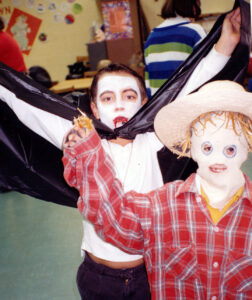Beggars’ Night lore
10/1/2025
Kristian Day (the vampire) and a friend from an elementary class Halloween celebration in 1993.
With trick-or-treating returning on Halloween night in Des Moines after 87 years, I am going to take us on a deep dive into the lore, rumors and old wives’ tales that may have contributed to the creation of “Beggars’ Night.”
You have likely heard many of them before: razor blades in apples, poisoned candy, pins and needles inside soft candy, and laxative chocolate bars.
From age 6 to 13, I would receive a lecture from my mother about the candy I would trick-or-treat for. A Halloween episode of “Roseanne” from 1992 featured Roseanne taking a bite of chocolate and pretending that it contained a razor blade, causing her mouth to bleed profusely. It was a comedic bit that also struck a bit of fear. The show took place in the fictional town of Lansing, Illinois, and was supposedly an hour from Chicago. At the time, I lived in Rock Island, Illinois, about two and a half hours from Chicago. It was practically the same town.
This was also the era when internet was sparse, and there were no social media or instant news. Shows like “COPS” and “America’s Most Wanted” both informed and terrified audiences. The world could easily be seen as a scary place. Unfortunately, some of the Halloween stories were used as cover-ups.
In 1970, 5-year-old Kevin Tonston from Detroit consumed his parent’s heroin and died. The parents attempted to cover it up by sprinkling bits of the heroin on his Halloween candy. The New York Times ran with this story on Nov. 7 , creating a frenzy. The mother said Kevin had spent the night at home with his brother. He ate Halloween candy and then suddenly began to sweat and breathe heavily. He eventually fell asleep and never woke up. Lab tests showed heroin was in his Halloween candy. However, it was eventually discovered that his parents tried to cover up the unfortunate disaster.
Ronald “The Candy Man” O’Bryan (also known as The Pixy Stix Killer) was convicted in 1974 for poisoning his 8-year-old son with potassium cyanide-laced Pixy Stix that he hid inside his trick-or-treat bag on Halloween night in Pasadena, Texas. O’Bryan was an optician and served as a deacon at his church, sang in the choir and drove a school bus. During the trial, he attempted to use urban legends of poisoned Halloween candy as his defense. He cited “The Mad Poisoner,” but there were no facts proving the stories to be true. He was convicted in 1975 for capital murder and was executed in 1984.
On a lighter note, in 1959, a California dentist distributed candy-coated laxative pills to trick-or-treaters. No one was seriously harmed. I may have attempted to do this, if laxatives weren’t so expensive.
Most of the illnesses kids would get from Halloween would be from candy going bad or homemade treats not being properly prepared. Harm was not the intent, but things happened, and it was easily passed off as, “They will be fine in the morning.” It was the 1970s and 1980s, after all.
Some of these myths were a distraction to the real danger, which was — and still is — kids getting hit by cars. Children are running around on the streets and having a good time, and none of them look like a real person. Looking out my windows on Polk Boulevard, I see motorists driving 40 mph like it is no one’s business, yet the DMPD puts a speed camera on Ingersoll and hands out tickets to folks going 36 mph in a 25 mph zone.
Have a happy Halloween. The city is going to be alive this year, so take it all in — carefully. ♦
Kristian Day is a filmmaker and writer based in Des Moines. He also hosts the syndicated Iowa Basement Tapes radio program on 98.9 FM KFMG. Instagram: @kristianday | Twitter: @kristianmday















